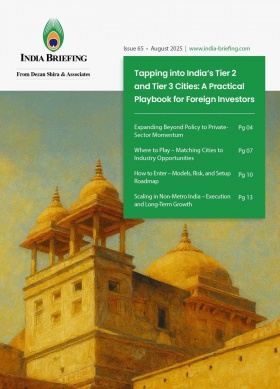India and China Resume Direct Passenger Flights: Boost for Trade, Tourism, and Regional Connectivity
India and China resumed direct passenger flights in October 26, 2025, marking a major milestone in restoring cross-border connectivity and rebuilding bilateral confidence after nearly five years of suspension.
The latest development comes as part of a broader strategy to revitalize economic, cultural, and people-to-people exchanges between the two Asian giants.
Revival of India-China air connectivity fuels trade and travel optimism
After a five-year hiatus, direct air connectivity between India and China resumed on October 26, 2025, with IndiGo’s inaugural Kolkata-Guangzhou flight. This signals renewed optimism among travel and trade operators in India. The development is expected to strengthen business mobility and tourism links while boosting cargo and export activities between the two countries.
Industry stakeholders anticipate that Kolkata could soon gain additional direct connections to West Asia and the Far East. Efforts are also underway to restore China Eastern Airlines’ Kolkata-Kunming route, which was suspended during the COVID-19 pandemic. According to industry experts, discussions with China Eastern have been positive, although a restart date has yet to be finalized. Media reports also indicate that the Travel Agents Federation of India (TAFI) has requested a daily service to Kunming, expanding on the airline’s earlier five-day schedule.
Passenger and cargo traffic to China has shown improvement, supported by IndiGo’s new daily service to Guangzhou, which departs Kolkata at 10 p.m. IST and reaches its destination in approximately three and a half hours. Trade indicators also point to strengthening bilateral activity. India’s exports to China increased by 22 percent in the first half of FY 2025-26 compared to the same period in FY 2024-25. Highlighting this trend, Chinese Ambassador to India, Xu Feihong, recently stated the Chinese Embassy has issued 2,65,000 visas to Indian citizens in 2025. He also added that China is open to importing more premium Indian products and supporting India in offsetting the impact of the US tariffs, a positive sign for the potential expansion of air connectivity and trade cooperation.
Strategic and diplomatic context
The resumption follows a consensus reached at the Shanghai Cooperation Organization (SCO) meeting in Tianjin on August 31, 2025. Chinese Foreign Ministry spokesperson Guo Jiakun described the initiative as a “cooperative pas de deux of the dragon and the elephant,” emphasizing the mutual commitment to strengthening long-term engagement.
Both governments appear to be prioritizing pragmatic cooperation even as broader geopolitical challenges remain. Improved connectivity is expected to enhance business travel, tourism, and diplomatic exchanges, while signaling to regional partners that India-China relations in 2025 are entering a more stable phase focused on shared growth and peace.
Guo noted that closer transport and trade links between the two countries – representing over 2.8 billion people – will promote regional stability and prosperity across Asia, aligning with the economic integration goals of the SCO, BRICS, and RCEP frameworks.
IndiGo leads the first route between India and China
IndiGo Airlines commenced first direct service between Kolkata and Guangzhou using Airbus A320neo aircraft.
- Departure: 10:00 p.m. IST from Kolkata
- Arrival: 4:05 a.m. local time in Guangzhou
This was the first direct India-China flight since 2020, signaling renewed mobility for professionals, students, and tourists.
Earlier in October 2025, IndiGo CEO Pieter Elbers described the move as “a significant step in strengthening our international network,” noting that it will “enable greater movement of people, goods, and ideas between two of the world’s fastest-growing economies.”
Industry observers expect additional routes connecting Delhi, Mumbai, and Bengaluru to Chinese commercial hubs like Shanghai, Chengdu, and Shenzhen to follow during the winter 2025 schedule.
Additional flights
Apart from IndiGo, Air India has announced plans to resume direct flights to Shanghai before the end of 2025, expanding India’s long-haul connectivity with China. Government officials also confirmed that Akasa Air intends to launch its own routes to Chinese destinations in the near future, reflecting growing commercial interest in the India-China corridor.
Further, India’s Directorate General of Civil Aviation (DGCA) has already approved China Eastern Airlines to operate five weekly Shanghai-Delhi passenger flights. Additional applications in the passenger category have been filed by Air China and Shandong Airlines, while China Southern Airlines and Sichuan Airlines have sought clearances to operate dedicated cargo flights between the two countries.
Economic and sectoral impact
Tourism and hospitality rebound
Before the pandemic, nearly 500 flights per month operated between major Indian and Chinese cities. The resumption is expected to revitalize bilateral tourism, with rising demand for cultural, wellness, and heritage travel.
Indian tourism stakeholders anticipate an influx of Chinese visitors, while Indian travelers gain direct access to China’s business, education, and retail markets.
Boost to bilateral trade and business travel
Direct air links will lower travel costs, shorten logistics times, and improve coordination for business delegations, sourcing teams, and after-sales service providers.
China remains a critical partner for India’s infrastructure, electronics, and machinery imports, while Indian pharmaceutical, IT, and professional service firms are well-positioned to expand into Chinese markets.
Support for services and supply chains
The reopening of routes supports smoother regional supply chain management. Cross-border business exchanges can now be conducted more efficiently, benefiting industries such as:
- Electronics and semiconductors
- Renewable energy and green tech
- Pharmaceutical manufacturing
- Engineering, procurement, and construction (EPC)
This is expected to improve services trade and investment facilitation between the two economies.
Diplomatic reset and confidence-building
The flight resumption forms part of a larger India-China bilateral reset in 2025, following years of limited engagement.
Recent initiatives include:
- Reopening border trade through the Lipulekh, Shipki La, and Nathu La passes.
- Resumption of the Kailash Manasarovar Yatra, signaling broader normalization.
- Restoration of fertilizer, rare earth, and machinery exports from China to India, essential for key sectors.
Momentum for these steps accelerated after Chinese Foreign Minister Wang Yi’s visit to New Delhi (August 18-19, 2025), where agreements were reached to restart flights and update the India-China Air Services Agreement.
The Indian Embassy in Beijing confirmed via WeChat on October 2, 2025, that flights will resume “in line with the winter schedule,” pending operational clearances, and will “facilitate people-to-people contact and business exchanges.”
Expert insights: A symbolic yet strategic step
According to Liu Xiaoxue, Associate Research Fellow at the Chinese Academy of Social Sciences, the move carries strong symbolic significance.
Speaking to Global Times, Liu said: “As more routes reopen, the two sides are expected to see new growth momentum in tourism, services trade, and people-to-people exchanges. Given the complexity of China-India relations, cooperation and competition are likely to coexist, and future progress will require patience, pragmatism, and strategic foresight.”
The tourism, hospitality, and education sectors are expected to benefit first, followed by logistics, financial services, and professional consulting – areas that rely on physical presence and regular travel.
Business and investment advisory
For Indian companies
- Operational benefits: Improved logistics for supplier visits, trade fairs, and technical cooperation.
- Market entry opportunities: Growing demand for Indian wellness tourism, education, and cultural exports in China.
For Chinese companies
- Re-entry into Indian markets: Eased travel facilitates business development and investment missions in India’s consumer, automotive, and renewable sectors.
- Partnership facilitation: Simplifies joint ventures, technology transfer discussions, and cross-border due diligence.
For global investors
- Positive signal of normalization: Reflects improved diplomatic communication and a stable trade environment.
- Stronger regional integration: Enhances India and China’s roles as production and consumption hubs within Asia’s supply chains.
Build Your Asia Business with Expert Support
Dezan Shira & Associates provides strategic market entry and cross-border advisory services across Asia. Whether you are expanding into India, engaging in China trade, or diversifying your Asian operations, our experts can help you navigate regulatory frameworks, identify local partners, set up local operations, and optimize tax and logistics strategies.
Contact us at India@dezshira.com or visit www.dezshira.com
Regional outlook: Pathway to deeper connectivity
Reinstating India-China flights is more than a transportation update – it is a confidence-building measure signaling cautious normalization.
As routes expand, both countries could leverage this momentum to:
- Develop subnational cooperation between major industrial hubs (e.g., Bengaluru-Shenzhen, Chennai-Chengdu).
- Strengthen business tourism corridors and academic exchanges.
- Reinforce Asia’s connectivity and resilience within global supply networks.
Conclusion
The resumption of direct India-China passenger flights in 2025 marks a turning point in bilateral relations. It shows the readiness of both nations to move from cautious diplomacy to constructive engagement.
For businesses and investors, this development presents new opportunities in trade, travel, and collaboration, as India and China gradually re-open their skies and rebuild trust.
(This article was originally published on October 16, 2025. It was updated on October 27, 2025.)
About Us
India Briefing is one of five regional publications under the Asia Briefing brand. It is supported by Dezan Shira & Associates, a pan-Asia, multi-disciplinary professional services firm that assists foreign investors throughout Asia, including through offices in Delhi, Mumbai, and Bengaluru in India. Dezan Shira & Associates also maintains offices or has alliance partners assisting foreign investors in China, Hong Kong SAR, Vietnam, Indonesia, Singapore, Malaysia, Mongolia, Dubai (UAE), Japan, South Korea, Nepal, The Philippines, Sri Lanka, Thailand, Italy, Germany, Bangladesh, Australia, United States, and United Kingdom and Ireland.
For a complimentary subscription to India Briefing’s content products, please click here. For support with establishing a business in India or for assistance in analyzing and entering markets, please contact the firm at india@dezshira.com or visit our website at www.dezshira.com.
- Previous Article GST Registration in 72 Hours: India’s New Auto-Approval System to Begin Nov. 1, 2025
- Next Article Understanding India’s New HSN Code Guidebook 2025








